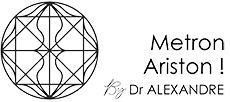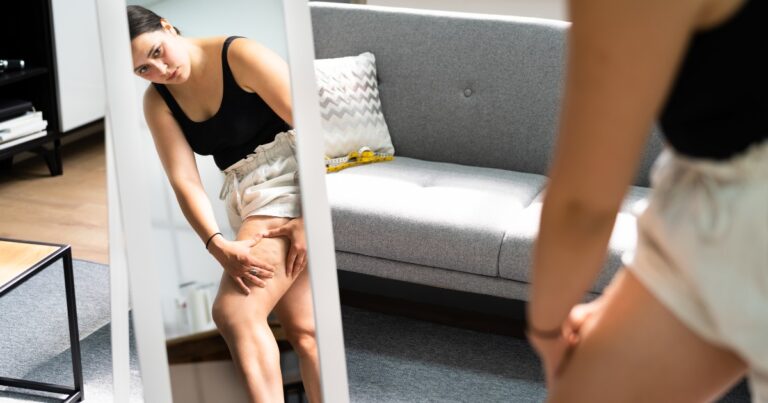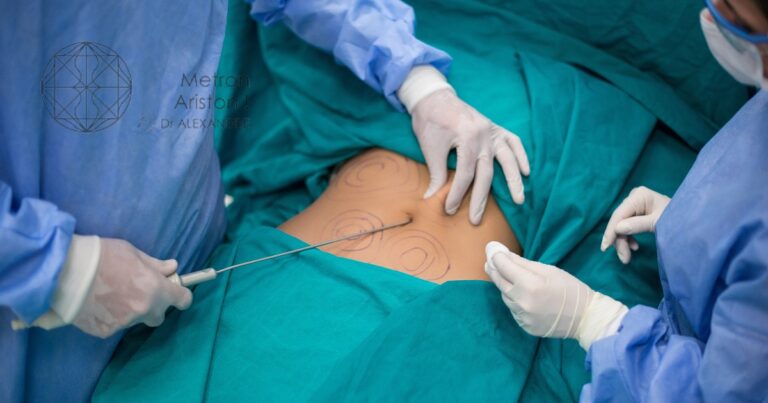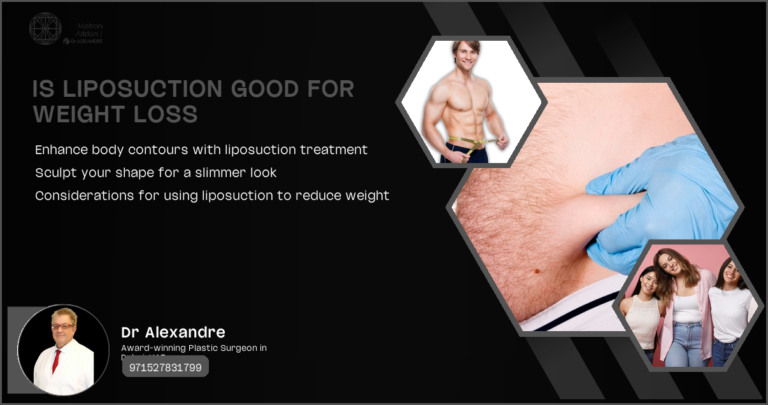Can Liposuction Remove Excess Skin? Understanding the Limitations and Solutions
Liposuction is a popular cosmetic procedure aimed at removing excess fat from specific areas of the body. However, many people wonder, “Can liposuction remove excess skin?” and “Does liposuction leave excess skin?”
These are important questions to consider when evaluating the potential outcomes of the procedure. In this article, we will explore the relationship between liposuction and skin elasticity, the factors affecting skin retraction, and the various solutions available for addressing excess skin.
Can Liposuction Remove Excess Skin?
The Relationship Between Liposuction and Skin Elasticity
Liposuction primarily targets fat removal, not skin tightening. The procedure involves suctioning out fat deposits, which can lead to a reduction in volume beneath the skin. However, the skin’s ability to retract and conform to the new contours depends largely on its elasticity.
Skin elasticity is influenced by factors such as age, genetics, and lifestyle habits. Younger individuals with good skin elasticity may experience better skin retraction post-liposuction, while older individuals or those with less elastic skin may notice sagging.
- Liposuction targets fat, not skin.
- Skin elasticity varies among individuals.
- Younger skin generally retracts better.
Factors Affecting Skin Retraction After Liposuction
Several factors can influence how well the skin retracts after liposuction. These include the amount of fat removed, the area of the body treated, and the patient’s overall skin quality. For instance, areas with thicker skin, like the abdomen, may show better retraction compared to areas with thinner skin, such as the arms.
Additionally, the skill of the surgeon plays a crucial role in minimizing the risk of excess skin.
- The amount of fat removed impacts skin retraction.
- Body area treatment affects skin tightening.
- The surgeon’s expertise is critical.
Understanding Post-Liposuction Skin Texture
Causes of Loose Skin After Liposuction
Loose skin after liposuction can occur when the skin fails to retract adequately to the new body contours. This is often due to a lack of skin elasticity or excessive fat removal.
Rapid weight loss can also contribute to loose skin, as the skin may not have enough time to adjust to the body’s new shape. It’s important to have realistic expectations and discuss potential outcomes with a qualified surgeon.
- Lack of skin elasticity can lead to loose skin.
- Excessive fat removal may cause sagging.
- Rapid weight loss impacts skin adjustment.
Skin Elasticity and Its Impact on Liposuction Results
Skin elasticity is a key determinant of liposuction results. Elastic skin can bounce back and conform to the body’s new shape, while inelastic skin may remain loose. Factors such as collagen production, hydration, and sun exposure can affect skin elasticity. Maintaining a healthy lifestyle and skincare routine can support skin health and improve post-liposuction outcomes.
- Elastic skin conforms better post-liposuction.
- Collagen and hydration affect skin elasticity.
- A healthy lifestyle supports skin health.
Combining Liposuction with Skin Tightening Procedures
Popular Add-Ons to Enhance Liposuction Outcomes
To address the issue of excess skin, many patients opt to combine liposuction with skin tightening procedures. Popular add-ons include tummy tucks, body lifts, and arm lifts. These procedures can help remove excess skin and improve overall body contours. Combining treatments can lead to more satisfying results and a smoother appearance.
- Tummy tucks remove excess abdominal skin.
- Body lifts enhance overall body contours.
- Arm lifts target sagging skin on the arms.
Benefits of Combining Treatments for Optimal Results
Combining liposuction with skin tightening procedures offers several benefits. It can lead to more comprehensive body contouring, reduce the risk of sagging skin, and enhance the overall aesthetic outcome. Patients can achieve a more toned and youthful appearance, boosting their confidence and satisfaction with the results.
- Comprehensive body contouring.
- Reduced risk of sagging skin.
- Enhanced aesthetic outcomes.
Surgical Options for Addressing Excess Skin After Liposuction
Tummy Tuck (Abdominoplasty)
A tummy tuck, or abdominoplasty, is a surgical procedure that removes excess skin and fat from the abdominal area. It also tightens the underlying muscles, resulting in a firmer and flatter abdomen. This procedure is ideal for individuals who have undergone significant weight loss or have loose skin after liposuction.
- Removes excess abdominal skin.
- Tightens underlying muscles.
- Ideal for post-weight loss patients.
Body Lift Procedures
Body lift procedures are designed to remove excess skin and fat from multiple areas of the body, such as the thighs, buttocks, and abdomen. These procedures are often recommended for individuals who have lost a significant amount of weight and have loose skin in various areas. A body lift can improve body contours and enhance overall appearance.
- Targets multiple body areas.
- Removes excess skin and fat.
- Improves body contours.
Arm Lift (Brachioplasty)
An arm lift, or brachioplasty, is a surgical procedure that removes excess skin and fat from the upper arms. This procedure is ideal for individuals with sagging skin on their arms, often referred to as “bat wings.” An arm lift can result in smoother, more toned arms and improved self-confidence.
- Removes excess arm skin.
- Targets “bat wings.”
- Results in toned arms.
Non-Surgical Interventions for Skin Tightening Post-Liposuction
Radiofrequency Treatments
Radiofrequency treatments use energy waves to heat the deeper layers of the skin, stimulating collagen production and tightening the skin. This non-invasive procedure can improve skin elasticity and reduce the appearance of sagging skin. It’s a popular option for individuals seeking a non-surgical solution to excess skin.
- Uses energy waves to heat skin.
- Stimulates collagen production.
- Non-invasive skin tightening.
Ultrasound-Based Therapies
Ultrasound-based therapies, such as Ultherapy, use focused ultrasound energy to lift and tighten the skin. This treatment targets the deep layers of the skin, promoting collagen production and improving skin elasticity. It’s a safe and effective option for individuals looking to enhance their post-liposuction results without surgery.
- Uses focused ultrasound energy.
- Promotes collagen production.
- Safe and effective skin tightening.
Laser Skin Tightening
Laser skin tightening uses laser energy to heat the skin, stimulating collagen production and improving skin elasticity. This non-invasive procedure can reduce the appearance of loose skin and enhance overall skin texture. It’s a popular choice for individuals seeking a quick and effective solution to excess skin.
- Uses laser energy to heat skin.
- Stimulates collagen production.
- Quick and effective skin tightening.
Candidacy for Liposuction and Skin Tightening Procedures
Ideal Candidates for Combined Treatments
Ideal candidates for combined liposuction and skin tightening procedures are individuals with good overall health, realistic expectations, and specific areas of excess fat and skin. These candidates should have a stable weight and be committed to maintaining a healthy lifestyle post-procedure. A consultation with a qualified surgeon, like Dr. Alexandre, can help determine candidacy.
- Good overall health.
- Realistic expectations.
- Stable weight and healthy lifestyle.
Factors Dr. Alexandre Considers During Consultations
During consultations, Dr. Alexandre considers several factors to determine the best treatment plan for each patient. These factors include the patient’s medical history, skin quality, and aesthetic goals. Dr. Alexandre also evaluates the areas of concern and discusses potential outcomes and risks with the patient.
- Medical history and skin quality.
- Aesthetic goals and areas of concern.
- Potential outcomes and risks.
Recovery and Results: What to Expect
Typical Recovery Timeline for Liposuction with Skin Tightening
The recovery timeline for liposuction with skin tightening varies depending on the extent of the procedures. Generally, patients can expect to resume normal activities within a few weeks, with full recovery taking several months. It’s important to follow post-operative care instructions and attend follow-up appointments to ensure optimal healing.
- Resume normal activities in a few weeks.
- Full recovery takes several months.
- Follow post-operative care instructions.
Long-Term Outcomes and Maintenance
Long-term outcomes of liposuction with skin tightening can be highly satisfying, with improved body contours and enhanced skin texture. To maintain results, patients should adopt a healthy lifestyle, including regular exercise and a balanced diet. Regular follow-up appointments with the surgeon can also help monitor progress and address any concerns.
- Improved body contours and skin texture.
- Healthy lifestyle for maintenance.
- Regular follow-up appointments.
Tips for Maintaining Skin Elasticity Post-Liposuction
Nutrition and Hydration for Skin Health
Proper nutrition and hydration are essential for maintaining skin elasticity post-liposuction. A diet rich in vitamins, minerals, and antioxidants can support collagen production and skin health. Staying hydrated helps keep the skin supple and resilient, reducing the risk of sagging.
- Diet rich in vitamins and antioxidants.
- Supports collagen production.
- Hydration keeps skin supple.
Exercise and Its Impact on Skin Tightening
Regular exercise can have a positive impact on skin tightening after liposuction. Physical activity promotes blood circulation, which supports skin health and elasticity. Strength training exercises can also help tone the underlying muscles, enhancing overall body contours and reducing the appearance of loose skin.
- Promotes blood circulation.
- Supports skin health and elasticity.
- Tones underlying muscles.
The Importance of Choosing a Qualified Surgeon
Credentials to Look for in a Liposuction Specialist
Choosing a qualified surgeon is crucial for achieving optimal liposuction results. Look for a board-certified plastic surgeon with extensive experience in liposuction and body contouring procedures. A reputable surgeon should have a track record of successful outcomes and positive patient reviews.
- Board-certified plastic surgeon.
- Extensive experience in liposuction.
- Successful outcomes and positive reviews.
Questions to Ask During Your Consultation
During your consultation, it’s important to ask the surgeon key questions to ensure you’re making an informed decision. Inquire about the surgeon’s experience, the techniques they use, and the potential risks and benefits of the procedure. Discuss your aesthetic goals and ask for before-and-after photos of previous patients.
- Inquire about surgeon’s experience.
- Discuss techniques and potential risks.
- Review before-and-after photos.px)
FAQ’s
Does Liposuction Cause Sagging Skin?
Liposuction does not directly cause sagging skin, but it can lead to loose skin if the skin lacks elasticity. Factors such as age, genetics, and lifestyle habits can influence how the skin responds to liposuction. To minimize the risk of sagging skin, it’s important to maintain a healthy lifestyle and consider combining liposuction with skin tightening procedures. Liposuction scarring minimal means the surgery leaves very small marks on your skin These tiny marks are hard to see and often fade away over time Liposuction mortality risks While rare some people can die from liposuction surgery due to complications like infections or blood clots
Liposuction procedure aches After getting liposuction people often feel sore and achy in the areas where fat was removed These
How Long Does It Take for Skin to Tighten After Liposuction?
The timeline for skin tightening after liposuction varies among individuals. Factors such as age, skin elasticity, and the amount of fat removed can affect the duration. Generally, it can take several months for the skin to fully adjust to the new body contours. Patients should follow their surgeon’s post-operative care instructions to support optimal skin retraction.
Can You Get Rid of Loose Skin After Liposuction?
Yes, there are several treatment options for addressing loose skin after liposuction. Surgical procedures like tummy tucks and body lifts can remove excess skin, while non-surgical treatments like radiofrequency and laser therapy can improve skin elasticity. Maintaining a healthy lifestyle with proper nutrition and exercise can also support skin tightening.








